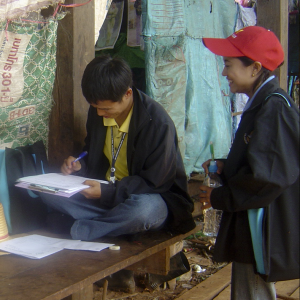The role of population registers
Can we correctly identify immigrant populations in the register?
The availability of both variables is particularly desirable because the increasing numbers of naturalised residents, a growing second-generation population or the return of past and recent emigrants often blurs the frontier between immigrants/natives and foreigners/nationals. Furthermore, in order to capture 2nd generation immigrants, registers should also include and make available information about parents (at least their country of birth).
Figure 1. Variables available for the identification of immigrant origin populations in different European Population Registers
| Good enough | Limited | Very limited |
|
NL: country of birth + citizenship + "migration background" with country of birth of his/her parents (identify 2nd generation) DK: SW: country of birth + citizenship + same information for parents and grandparents (identify 2nd and 3rd generation) |
ES, DE: country of birth + citizenship | IT: citizenship only |
Legend: NL = Netherlands, DK = Denmark, SW = Sweden, ES = Spain, DE = Germany, IT = ItalySource: Authors’ own elaboration. |
||
Sometimes the legal framework hinders the possibility of identifying part of the population of immigrant origin in the registers. For instance, German data protection law restricts data collection to data that are necessary for public administration. For this reason, the inclusion of the variable “migration background” (including parental information) into the microcensus 2004 0required a specific exceptional regulation.
Is the whole immigrant population registered?
Figure 2. Inclusion/exclusion of irregular migrants and incentives for registration in Population Registers
| Good enough | Limited and very limited | |
| Exclusion |
ES: irregular immigrants included and strong incentives (and guarantees): access to basic services, proof of residence for regularization. DE: almost the entire population living within its territory, regardless of citizenship and right of residence but excluding some categories of paperless migrants. |
IT, DK, SW: only regular immigrants (with residence permit). NL: only regular immigrants (with residence permit). Asylum seekers are registered when they get a residence permit or if they have stayed for 6 months in an Asylum Seeker Centre. |
| Incentives |
ES: mandatory for all residents, and strong incentives for registration for all (access to basic services, proof of residence for regularization). DE: registration is compulsory no later than 2 weeks after moving in a municipality. Fines can be imposed otherwise, and access to social services is impossible without registration. |
IT: mandatory (for all migrants with residence permits and after 3 months for EU citizens), but no incentives (estimated 15% under-coverage of regular and irregular migrant population). NL: mandatory for stays of 4 months or more, but no incentives (in particular for EU migrants). DK: mandatory for stays longer than 3 or 6 months but no particular incentives. SW: mandatory for stays of 1 year or more but no particular incentives. |
Legend: NL = Netherlands, DK = Denmark, SW = Sweden, ES = Spain, DE = Germany, IT = ItalySource: Authors’ own elaboration. |
||
Are these data accessible for researchers?
Figure 3. Access to data in Population Registers to construct sampling frames
| Good enough | Limited and very limited |
|
DK, SW: fully available to researchers affiliated with national research institutions, and possibility to link with specialized registers (longitudinal information). NL: direct access to types of migrants defined by legal status or migration motive, and possibility to link with census, specialized registers and large surveys. ES: available to researchers with official support from some Spanish Public Administration (other than universities). Public universities can benefit from a 15% discount in the final price for the sample. Possibility to link with specialized registers virtually unused so far. |
IT: no central register, municipalities have to be approached individually, at the discretion of the public officer DE: no central register, district or towns (several thousand) have to be approached individually to negotiate data release and costs for complex sample selections. This means that geographically extensive sampling is extremely costly and risky. The legal framework does not allow linkage of public registers. |
Legend: NL = Netherlands, DK = Denmark, SW = Sweden, ES = Spain, DE = Germany, IT = ItalySource: Authors’ own elaboration. |
|
Is it feasible (and affordable) to locate and interview the selected migrants?
Figure 4. De-registration in Population Registers
| Good enough | Limited | Very limited |
|
ES: mandatory renewal of registration every 2 (non-EU) or 5 years (EU and permanent residents) since 2006 and 2011. No strong incentives, but systematic cleaning-up operations on an on-going basis. DK: mandatory re-registration within 5 days of residence change within country. Failure to communicate this may result in lack of access to public services and benefits in new municipality of residence. Mandatory re-registration if moving abroad for 6 months but no incentives. Over-coverage is corrected when absence is identified. (Estimate at 0.97% of foreign-born population). |
SW: Mandatory de-registration if moving abroad for 6 months but no incentives. Over-coverage (estimated at 4-8% of foreign-born population) is corrected when absence is identified (failure to renew stamp with Migration Agency) NL: Mandatory de-registration if moving abroad for 8 months but no incentives: Over-coverage is assessed with the help of the local authorities (the data are published separately, and added to the number of registered emigrants). |
IT: non-mandatory and no incentive for de-registration. Over-coverage is corrected only after every census. |
Legend: NL = Netherlands, DK = Denmark, SW = Sweden, ES = Spain, DE = Germany, IT = ItalySource: Authors’ own elaboration. |
||
Migrants also have, on average, higher vulnerability levels, making it harder to gain their trust to participate (leading to higher refusal rates). Distrust can be aggravated if it becomes clear that data facilitated by the administration are being used to single them out.
Improve the registers and meanwhile, let's collaborate!
Figure 5. Suggested best sampling strategies for individual countries (general immigrant population)
| Good enough | Limited and very limited |
|
ES: register-based sampling adjusting sampling strategy to diminish costs (e.g. using household as a sampling unit; clustering by neighborhoods; or introducing flexibility in contracts replacement and number of trips allowed. NL: register-based sampling using two-stage stratified sampling, excluding or merging municipalities with low numbers of immigrants |
DE: register-based sampling using two-stage approach (but costly due to decentralization) and alternative methods to include also irregular migrants IT: no registered-based sampling; use Centre Sampling Technique to include irregular migrants and obtain unbiased estimates |
Legend: NL = Netherlands, DK = Denmark, SW = Sweden, ES = Spain, DE = Germany, IT = ItalySource: Authors’ own elaboration. |
|
Disclaimer: The opinions expressed in this blog are those of the authors and do not necessarily reflect the views of the International Organization for Migration (IOM) or the United Nations. Any designations employed and the presentation of material throughout the blog do not imply the expression of any opinion whatsoever on the part of IOM concerning the legal status of any country, territory, city or area, or of its authorities, or concerning its frontiers and boundaries.
- 1Another criterion, more rarely used in Europe, is ethnicity. Additional pieces of information that are frequently relevant for sample selection are age and time of arrival.
- 2Moreover, since municipal budget depends on their total population, municipalities also take an interest (and actively campaigned) for registration of immigrants.






